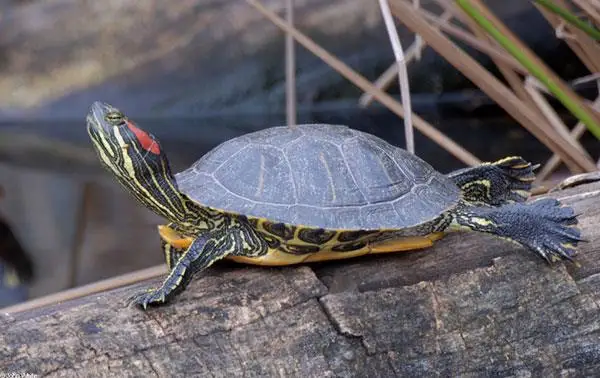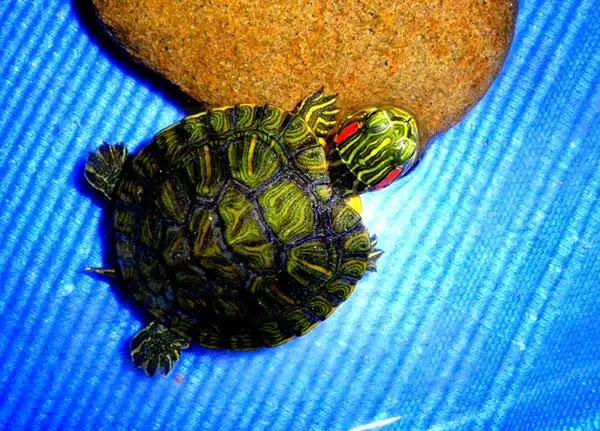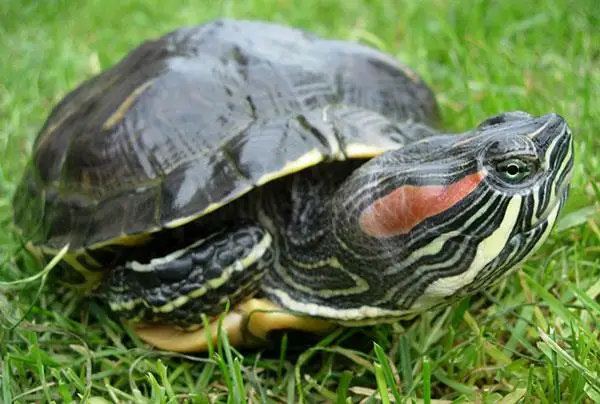Variety Overview
English Name: Trachemys Acripta Elegans
Aliases: Red-Eared Slider, Red-Eared Turtle, Brazilian Painted Turtle, Elegant Painted Turtle, Mahjong Turtle, Colorful Turtle
Origin: North America
Price: For sizes 3-4 cm approximately0.7 USD, for sizes 6-8 cm approximately 1.4 USD, for sizes 7-15 cm approximately 2.1 USD; large turtles range from 2.8 to 5.6 USD per kilogram.
Size: Total length about 15-25 cm
Lifespan: Approximately 25 years
Development Origin
The Brazilian turtle, also known as the red-eared slider (Trachemys scripta elegans), does not actually originate from Brazil. Instead, it is native to the Mississippi River and Rio Grande basins in North America. These turtles are highly valued for their edible, medicinal, and ornamental properties and are well-suited for artificial breeding.
Initially, what was referred to as the “Brazilian turtle” was indeed a type of painted turtle from Brazil. In the 1980s, China introduced this species. However, due to funding issues later on, they began importing red-eared sliders from their native habitat in the United States instead. Because juvenile turtles of both species look very similar and are hard to tell apart, people continued using the term “Brazilian turtle.” Over time, this name became synonymous with what is actually the Mississippi red-eared slider.
So when we talk about Brazilian turtles today, we’re really referring to turtles that come from the Mississippi River region—not Brazil.

Morphological Features and Identification
The Brazilian turtle has a broad head with a blunt snout. Its head and neck feature longitudinal yellow-green stripes. Behind its eyes are red stripes resembling ears—hence its name. The carapace (shell) is flat and comes in shades of emerald or apple green with a prominent central ridge. The scutes (plates) display alternating yellow-green ring patterns. Its plastron (belly shell) is light yellow adorned with irregular black circular, oval, or rod-shaped spots that are symmetrically arranged. The limbs are light green with gray-brown stripes running lengthwise; webbing exists between fingers and toes.
While males and females look similar in color, their weights vary significantly. Gender identification becomes clear when females weigh around 1000 grams while males weigh about 250 grams:
Female Turtles:
- Thin tail base
- Cloaca closer to rear edge of plastron
- Shallow notch formed by anal shields with wide angle
- Shorter & wider carapace
- Flat plastron without central depression
- Thin & short tail; cloaca within plastron
Alternatively pressing their limbs to prevent extension causing liquid secretion from cloaca indicates females weighing between 1000 to 2500 grams.
Male Turtles:
- Longer & narrower carapace
- Slightly concave center on plastron
- Thick & long tail base; cloaca farther from rear edge of plastron
- Deep notch formed by anal shields with narrow angle
Alternatively pressing their limbs to prevent extension causing reproductive organ extension from cloaca indicates males weighing up to 600 grams.
Maintenance Tips
Brazilian turtles enjoy sunbathing but not for extended periods. When keeping them outdoors, avoid placing their enclosure in areas with prolonged direct sunlight; ensure there is some shade. For indoor care, position a UV lamp about 30 cm away from the turtle’s tank and use it for 15-20 minutes daily. Make sure to prevent escapes by adding a mesh cover. During winter, allow the turtles to hibernate as temperatures drop. In summer, if possible, let them sunbathe during the day—preferably around 8 or 9 AM—and bring them back inside in the evening.

Feeding Techniques
Brazilian turtles (Red-eared sliders) are omnivorous creatures found in the wild but primarily carnivorous. In captivity, they favor animal-based foods like fish, pork, animal organs, clams, snails, bloodworms (chironomid larvae), red worms (tubifex worms), yellow mealworms (Tenebrio molitor), and fly maggots. They also consume plant-based items such as vegetable leaves, rice, and fruits. Common feed includes small fish, shrimp, pig liver, red worms, and even cockroaches. Red-eared sliders do not have specific feeding times; they eat both day and night. When hungry, they can exhibit aggressive food-snatching behavior where larger turtles may prey on smaller ones.
Although Brazilian turtles are omnivorous by nature, they have a preference for animal-based diets when bred in captivity—mainly poultry offal or pig organs along with fly maggots and mealworms. Here are some important tips for feeding Brazilian turtles:
- Establish a consistent feeding schedule: typically between 10 AM to 2 PM during spring and autumn; 7 AM to 9 AM or 6 PM to 7 PM during summer. Extreme temperatures can reduce their appetite.
- Designate a specific feeding area: this helps monitor their eating habits and activity levels.
- Ensure feed quality: it must be fresh without any unpleasant odor; clean leftovers thoroughly before removing excess tendons or skin to prevent indigestion. Avoid using tap water for aquatic feeding; sun-exposed water is recommended instead. Feeding them three to five times a week is generally sufficient.
